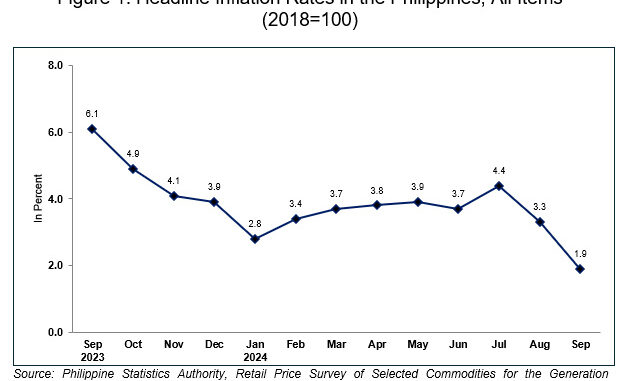
The Philippines’ inflation rate fell to its lowest level in over four years in September, primarily due to a slowdown in food and transportation costs.
In a report released on Friday, the Philippine Statistics Authority (PSA) said headline inflation dropped to 1.9 percent last month from 3.3 percent in August.
Last month’s inflation figure was in sharp contrast to its 6.1 percent level in September 2023, when the country was just recovering from a series of price surges mainly driven by supply issues in key agricultural products.
The easing of overall price pressures was in no small part traced to a decline in rice inflation, which dropped significantly to 5.7 percent from 14.7 percent the previous month.
Additionally, a steady supply of high-value crops amid favorable weather conditions reduced vegetable prices (-15.8 percent from -4.3 percent), serving to mitigate overall food inflation.
“This is the lowest inflation rate since the 1.6 percent inflation rate recorded in May 2020,” PSA stated.
In the first nine months of the year, inflation averaged 3.4 percent, which falls well within the government’s target range of 2 to 4 percent for 2024.
NEDA Secretary Arsenio Balisacan said the continued slowdown in inflation is expected to boost consumer confidence, driving higher spending and consumption and fueling business expansion.
“Additionally, easing food prices will relieve low-income households, enabling them to allocate more to other essential needs such as education and health. We will sustain the momentum as we assure the public that we will continue to pursue and carry out strategies to maintain stable prices of food and other commodities,” he added.
Balisacan highlighted the inflation-mitigating effect of Executive Order No. 62, issued by President Marcos in June 2024, which reduced rice tariffs to 15 percent to sustain sufficient rice supply and keep prices affordable amid rising global prices.
“While we expect lower tariffs to reduce rice prices, we should continuously support local production through increased agricultural funding to complement this short-term measure,” Balisacan said.
Meanwhile, the Bangko Sentral ng Pilipinas (BSP) noted that the September 2024 inflation outturn of 1.9 percent settled slightly below its forecast range of 2.0 to 2.8 percent.
“This latest inflation outturn remains consistent with the BSP’s assessment that inflation will continue to trend downwards over the succeeding quarters due to negative base effects and the easing of supply pressures for key food items,” the monetary regulator said in a statement on Friday.
“The downside risks are linked mainly to the impact of the lower import tariffs on rice, while upside risks come from higher electricity rates and external factors such as worsening geopolitical risks in the Middle East and Ukraine, which could impact global oil and food prices as well as the exchange rate,” the BSP added.
“The Monetary Board will continue to take a calibrated approach in ensuring price stability conducive to balanced and sustainable growth of the economy and employment,” the BSP assured ahead of the monetary policy meeting on October 16.
For his part, Finance Secretary Ralph Recto said that in view of the better-than-expected inflation outcome in September, the full-year rate is now expected to settle at around 3.2 percent.
“This gives the BSP more room to be aggressive in its monetary policy easing to help the economy grow at a faster rate and support the government in increasing its revenue collections,” he added.
As this developed, House Speaker Martin Romualdez vowed that the Lower Chamber would continue to back policies that ensure sufficient food supply at affordable prices.
“The intervention measures taken by the government under the leadership of President Marcos Jr. are now yielding positive results,” he said.
He specifically cited the President’s decision to drastically cut the rice import tariff from 35 percent to just 15 percent, and the direct sale of rice to the public through Kadiwa stores.
“These twin steps have significantly reduced the retail price of rice, from above P50-P60 per kilo to P40-P42 per kilo, or by at least 20 percent,” Romualdez noted.


Be the first to comment